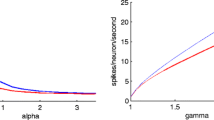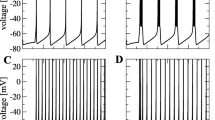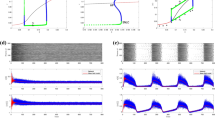Abstract
Many developing neural systems exhibit spontaneous activity (O’Donovan, Curr Opin Neurobiol 9:94–104, 1999; Feller, Neuron 22:653–656, 1999) characterized by episodes of discharge (active phases) when many cells are firing, separated by silent phases during which few cells fire. Various models exhibit features of episodic behavior by means of recurrent excitation for supporting an episode and slow activity-dependent depression for terminating one. The basic mechanism has been analyzed using mean-field, firing-rate models. Firing-rate models are typically formulated ad hoc, not derived from a spiking network description, and the effects of substantial heterogeneity amongst the units are not usually considered. Here we develop an excitatory network of spiking neurons (N-cell model) with slow synaptic depression to model episodic rhythmogenesis. This N-cell model displays episodic behavior over a range of heterogeneity in bias currents. Important features of the episodic behavior include orderly recruitment of individual cells during silent phases and existence of a dynamical process whereby a small critical subpopulation of intermediate excitability conveys synaptic drive from active to silent cells. We also derive a general self-consistency equation for synaptic drive that includes cell heterogeneity explicitly. We use this mean-field description to expose the dynamical bistability that underlies episodic behavior in the heterogeneous network. In a systematic numerical study we find that the robustness of the episodic behavior improves with increasing heterogeneity. Furthermore, the heterogeneity of depression variables (imparted by the heterogeneity in cellular firing thresholds) plays an important role in this improvement: it renders the network episodic behavior more robust to variations in excitability than if depression is uniformized. We also investigate the effects of noise vs. heterogeneity on the robustness of episodic behavior, especially important for the developing nervous system. We demonstrate that noise-induced episodes are very fragile, whereas heterogeneity-produced episodic rhythm is robust.










Similar content being viewed by others
References
Beggs, J. M., & Plenz, D. (2003). Neuronal avalanches in neocortical circuits. Journal of Neuroscience, 23, 11167–11177.
Ben-Ari, Y. (2001). Developing networks play a similar melody. Trends in Neuroscience, 24, 353–360.
Borodinsky, L. N., Root, C. M., Cronin, J., Sann, S. B., Gu, X., & Spitzer, N. C. (2004). Activity-dependent homeostatic specification of transmitter expression in embryonic neurons. Nature, 429, 523–530.
Burden, R. L., & Faires, J. D. (2001). Numerical analysis (7th ed.). Pacific Grove, CA: Brooks/Cole.
Cherubini, E., Gaiarsa, J. L., & Ben-Ari, Y. (1991). GABA: an excitatory transmitter in early postnatal life. Trends in Neuroscience, 14, 515–519.
Chub, N., & O’Donovan, M. J. (1998). Blockade and recovery of spontaneous rhythmic activity after application of neurotransmitter antagonists to spinal networks of the chick embryo. Journal of Neuroscience, 18, 294–306.
Compte, A., Sanchez-Vives, M. V., McCormick, D. A., & Wang, X. J. (2003). Cellular and network mechanisms of slow oscillatory activity (<1 Hz) and wave propagations in a cortical network model. Journal of Neurophysiology, 89, 2707–2725.
Ermentrout, B. (1994). Reduction of conductance based models with slow synapses to neural nets. Neural Computation, 6, 679–695.
Fedirchuk, B., Wenner, P., Whelan, P. J., Ho, S., Tabak, J., & O’Donovan, M. J. (1999). Spontaneous network activity transiently depresses synaptic transmission in the embryonic chick spinal cord. Journal of Neuroscience, 19, 2102–2112.
Feller, M. B. (1999). Spontaneous correlated activity in developing neural circuits. Neuron, 22, 653–656.
Giugliano, M., Darbon, P., Arsiero, M., Lüscher, H.-R., & Streit, J. (2004). Single-neuron discharge properties and network activity in dissociated cultures of neocortex. Journal of Neurophysiology, 92, 977–996.
Hansel, D., Mato, G., Meunier, C., & Neltner, L. (1998). On numerical simulations of integrate-and-fire neural networks. Neural Computation, 10, 467–483.
Hanson, M. G., & Landmesser, L. T. (2004). Normal patterns of spontaneous activity are required for correct motor axon guidance and the expression of specific guidance molecules. Neuron, 43, 687–701.
Katz, L. C., & Shatz, C. J. (1996). Synaptic activity and the construction of cortical circuits. Science, 274, 1133–1138.
Latham, P. E., Richmond, B. J., Nelson, P. G., & Nirenberg, S. (2000). Intrinsic dynamics in neuronal networks. I. Theory. Journal of Neurophysiology, 83, 808–827.
Loebel, A., & Tsodyks, M. (2002). Computation by ensemble synchronization in recurrent networks with synaptic depression. Journal of Computational Neuroscience, 13, 111–124.
Marchetti, C., Tabak, J., Chub, N., O’Donovan, M. J., & Rinzel, J. (2005). Modeling spontaneous activity in the developing spinal cord using activity-dependent variations of intracellular chloride. Journal of Neuroscience, 25, 3601–3612.
O’Donovan, M. J. (1999). The origin of spontaneous activity in developing networks of the vertebrate nervous system. Current Opinions in Neurobiology, 9, 94–104.
Sernagor, E., Chub, N., Ritter, A., & O’Donovan, M. J. (1995). Pharmacological characterization of the rhythmic synaptic drive onto lumbosacral motoneurons in the chick embryo spinal cord. Journal of Neuroscience, 15, 7452–7464.
Shelley, M. J., & Tao, L. (2001). Efficient and accurate time-stepping schemes for integrate-and-fire neuronal networks. Journal of Computational Neuroscience, 11, 111–119.
Shriki, O., Hansel, D., & Sompolinsky, H. (2003). Rate models for conductance-based cortical neuronal networks. Neural Computation, 15, 1809–1841.
Stellwagen, D., & Shatz, C. J. (2002). An instructive role for retinal waves in the development of retinogeniculate connectivity. Neuron, 33, 357–367.
Strogatz, S. H. (2000). Nonlinear dynamics and chaos: With applications to physics, biology, chemistry, and engineering. Cambridge, MA: Perseus.
Tabak, J., O’Donovan, M. J., & Rinzel, J. (2006). Differential control of active and silent phases in relaxation models of neuronal rhythms. Journal of Computational Neuroscience, 21, 307–328.
Tabak, J., Rinzel, J., & O’Donovan, M. J. (2001). The role of activity-dependent network depression in the expression and self-regulation of spontaneous activity in the developing spinal cord. Journal of Neuroscience, 21, 8966–8978.
Tabak, J., Senn, W., O’Donovan, M. J., & Rinzel, J. (2000). Modeling of spontaneous activity in developing spinal cord using activity-dependent depression in an excitatory network. Journal of Neuroscience, 20, 3041–3056.
Timofeev, I., Grenier, F., Bazhenov, M., Sejnowski, T. J., & Steriade, M. (2000). Origin of slow cortical oscillations in deafferented cortical slabs. Cerebral Cortex, 10, 1185–1199.
Tsodyks, M., Uziel, A., & Markram, H. (2000). Synchrony generation in recurrent networks with frequency-dependent synapses. Journal of Neuroscience, 20(RC50), 1–5.
van Vreeswijk, C., & Hansel, D. (2001). Patterns of synchrony in neural networks with spike adaptation. Neural Computation, 13, 959–992.
Vladimirski, B. B. (2005). Modeling and analysis of spontaneous electrical episodic activity in the developing nervous system by means of a heterogeneous excitatory network of spiking neurons with slow synaptic depression and reduced mean-field models. Ph.D. diss., New York University, New York, NY.
Wenner, P., & O’Donovan, M. (2001). Mechanisms that initiate spontaneous network activity in the developing chick spinal cord. Journal of Neurophysiology, 86, 1481–1498.
Wiedemann, U. A., & Lüthi, A. (2003). Timing of network synchronization by refractory mechanisms. Journal of Neurophysiology, 90, 3902–3911.
Wilson, H. R., & Cowan, J. D. (1972). Excitatory and inhibitory interactions in localized populations of model neurons. Biophysical Journal, 12, 1–24.
Yvon, C., Czarnecki, A., & Streit, J. (2007). Riluzole-induced oscillations in spinal networks. Journal of Neurophysiology, 97, 3607–3620.
Acknowledgements
J. Rinzel was funded in part by NIMH (MH62595-01). M. O’Donovan and B. Vladimirski were funded in part by the intramural program of NINDS, NIH.
Author information
Authors and Affiliations
Corresponding author
Additional information
Action Editor: Nicolas Brunel
Electronic Supplementary Material
Below is the link to the electronic supplementary material.
Appendix
Appendix
1.1 Details of the mean-field description derivation
To obtain the expression for \(\hat{q}(g_{syn},\:I)\) given in (11), we perform the following steps.
-
1.
We solve Eq. (6) analytically assuming that synapses are activated for a short period of time relative to the interspike interval, i.e., ε q ≤ T(g syn , I). Using the integrating factor method, we obtain
$$q_i(t)\!=\!\!\left\{ \begin{array}{ll} {\frac{\alpha_q}{\alpha_q+\beta_q}}\!+\!\left(\! q_i(0)\!-\!{\frac{\alpha_q}{\alpha_q+\beta_q}} \!\right)\! e^{-(\alpha_q+\beta_q)t} & \ 0 \!\leq \!t \!\leq \!\epsilon_q \\ e^{-\beta_q(t-\epsilon_q)}q_i(\epsilon_q) & \ \epsilon_q \!<\! t\! \leq\! T_i \!\equiv \!T(g_{syn},\:I_i) \end{array} \right.$$(19)Since T i is the period of neuron i, we must have
$$\begin{array}{ll} q_i(T_i) & = q_i(0) \\ q_i(0) & = {\frac{\alpha_q}{\alpha_q+\beta_q}}\frac{e^{\beta_q\epsilon_q}-e^{-\alpha_q\epsilon_q}}{e^{\beta_q T_i}-e^{-\alpha_q\epsilon_q}} \end{array}$$ -
2.
Find the temporal average of the analytical solution:
$$\hat{q}(g_{syn},\:I_i)=\!\!\left\{ \begin{array}{ll} \!0, \mbox{ } T_i\!=\!+\infty \mbox{; otherwise:} & \ \nonumber\\ \!1/T_i \int_{0}^{T_i}q_i(t)dt \!=\!1/T_i \!\left( \int_{0}^{\epsilon_q} q_i(t)dt\!+\!\int_{\epsilon_q}^{T_i} \!q_i(t)dt \right) & \ \end{array} \right.$$For T i finite,
$$\int_{0}^{\epsilon_q} q_i(t)dt = {\frac{\alpha_q}{\alpha_q+\beta_q}}\epsilon_q +\!\left(\! q_i(0)\!-\!{\frac{\alpha_q}{\alpha_q+\beta_q}} \right)\!\frac{1}{\alpha_q+\beta_q}\left(1\!-\!e^{-(\alpha_q+\beta_q)\epsilon_q}\right)$$(20)$$\begin{array}{*{20}ll}\int_{\epsilon_q}^{T_i} q_i(t)dt &= \left[{\frac{\alpha_q}{\alpha_q+\beta_q}}+\left( q_i(0)-{\frac{\alpha_q}{\alpha_q+\beta_q}} \right)e^{-(\alpha_q+\beta_q)\epsilon_q}\right] \frac{1}{\beta_q}\left(1-e^{-\beta_q(T_i-\epsilon_q)}\right) \\&= \frac{1}{\beta_q}\left({\frac{\alpha_q}{\alpha_q+\beta_q}}\left(1-e^{-(\alpha_q+\beta_q)\epsilon_q}\right) -\left(1-e^{-(\alpha_q+\beta_q)\epsilon_q}\right)q_i(0)\right)\end{array}$$(21)Hence, combining the similar terms in (20) and (21), we obtain:
$$\hat{q}_i=r_i\left(c-\frac{d}{e^{\beta_q/r_i}-w}\right)$$(22)where
$$\begin{array}{ll} c & = \frac{\alpha_q\epsilon_q}{\alpha_q+\beta_q}+\frac{\alpha_q^2}{(\alpha_q+\beta_q)^2\beta_q}\left(1-e^{-(\alpha_q+\beta_q)\epsilon_q}\right) \\ d & = \frac{\alpha_q^2}{(\alpha_q+\beta_q)^2\beta_q}\left(e^{\beta_q\epsilon_q}-e^{-\alpha_q\epsilon_q}\right)\left(1-e^{-(\alpha_q+\beta_q)\epsilon_q}\right) \\ w & = e^{-\alpha_q\epsilon_q} \end{array}$$In general,
$$\hat{q}(g_{syn},\:I)=r(g_{syn},\: I) \left(c-\frac{d}{e^{\beta_q/r(g_{syn},\: I)}-w}\right)$$(23)Both (22) and (23) are valid for any firing rate. In particular, for low firing rates, we deduce from (11) that
$$\hat{q}(g_{syn},\:I) \approx c r(g_{syn},\: I)$$(24)For high firing rates, by using Taylor’s Formula in powers of \(\beta_q/r(g_{syn},\: I)\) and keeping the linear part only, we obtain:
$$\hat{q}(g_{syn},\:I) \approx \left(c\! - \!\frac{d}{1\!-\!w} \right)\! r(g_{syn},\: I)\! + \frac{b \beta_q}{(1\!-\!c)(1\!-\!c\!+\!\beta_q \tau_{ref})}$$(25)The β q τ ref term in the denominator is the minimum possible value of \(\beta_q/r(g_{syn},\: I)\). Thus, the temporally averaged synaptic activation is approximately linear in both cases, with the slope being shallower in the latter. The graph of \(\hat{q}(g_{syn},\:I)\) is shown in Fig. 11(b).
Panel (a): firing rate of the single leaky integrate-and-fire neuron without noise. Transition to repetitive firing occurs when Θ eff (g syn , I) = 1, i.e., along the straight line I = 1 + g syn (1 − V syn ). If either g syn or I is fixed at some level, the firing-rate as a function of the other variable possesses the characteristic logarithmic shape. Superimposed are also shown three firing-rate population profiles, corresponding to the three marked steady-state values of g syn on the lower, middle, and upper branches of the bifurcation diagram in Fig. 7(a). Panel (b): single-cell synaptic activation averaged over one interspike interval as a function of the cell’s firing rate. Note the linear parts for low and high firing rates, consistent with (24) and (25)
We also provide some additional details here. In this work, we use uniform distributions of bias currents on a finite interval (I min ; I max ). Then, (14) simplifies to
For general description purposes (e.g., this is how the bifurcation diagrams in Fig. 7 were generated), we can interpret (14) in terms of \({\overline{g}}_{syn}\) as a function of the self-consistent value of g syn . This allows us to avoid the numerical solution of (14) altogether, but is not applicable if the self-consistent value of g syn corresponding to a specific value of \({\overline{g}}_{syn}\) is required. The corresponding expression is
Rights and permissions
About this article
Cite this article
Vladimirski, B.B., Tabak, J., O’Donovan, M.J. et al. Episodic activity in a heterogeneous excitatory network, from spiking neurons to mean field. J Comput Neurosci 25, 39–63 (2008). https://doi.org/10.1007/s10827-007-0064-4
Received:
Revised:
Accepted:
Published:
Issue Date:
DOI: https://doi.org/10.1007/s10827-007-0064-4





